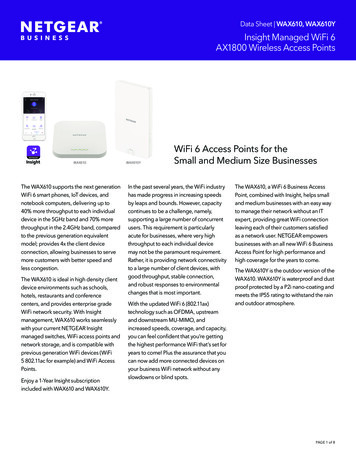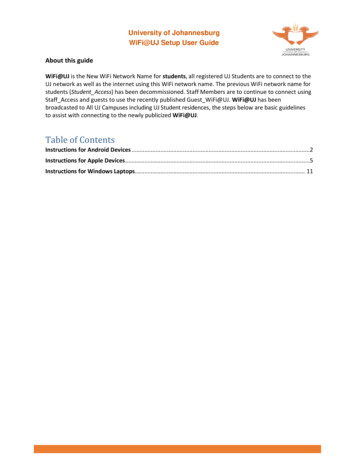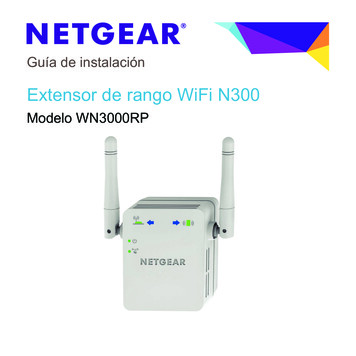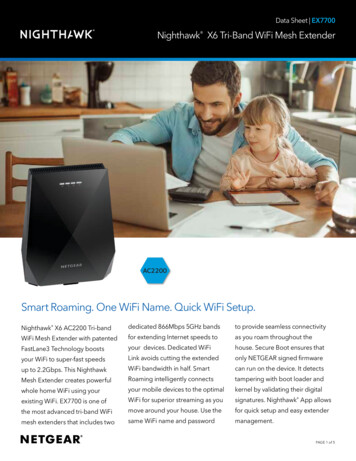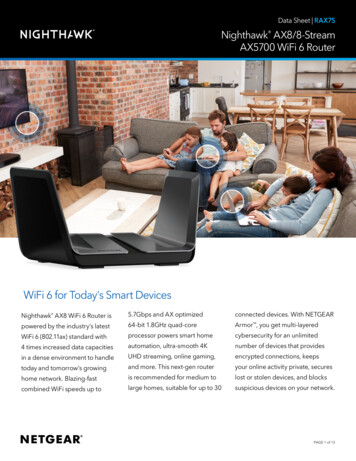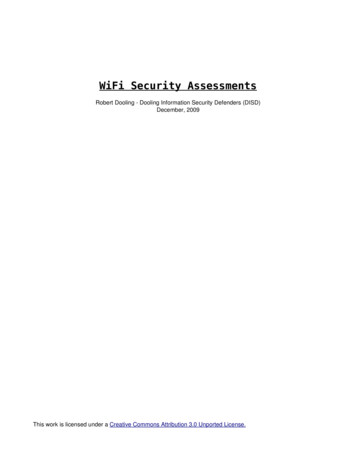
Transcription
WiFi Security AssessmentsRobert Dooling Dooling Information Security Defenders (DISD)December, 2009This work is licensed under a Creative Commons Attribution 3.0 Unported License.
Table of ContentsIntroduction.3Default configuration overview.4Default configuration attacks.7WEP configuration overview.11WEP configuration attacks.12WPA TKIP configuration overview.29WPA TKIP configuration attacks.30Recommendations.362
IntroductionThis paper is intended for anyone with an interest in the security of home to small to mediumbusiness (SMB) level wireless access points and WiFi networks – particularly, the types ofauthentication and encryption provided by these devices.Readers will find it helpful to be familiar with basic TCP/IP and WiFi (802.11) concepts, butexpertise is not required.The purpose of this paper is to demonstrate the ease with which some default or poorly configured wireless access point security configurations can be circumvented using readily available free software. This paper does not describe any new, previously undisclosed, orinnovative techniques in wireless security and analysis. This should emphasize the point thatthese type of attacks can be performed by a modestly skilled attacker.Unless otherwise specified, all of the tools mentioned in this paper are free, open source software(FOSS). This applies also to the DD WRT firmware used for the target access point. Additionally,the attacking system and sample target access point described in this paper are each more thanfive years old. Again, the minimal costs associated with these tools and hardware emphasizesthat an attacker need not be well funded to compromise a network.Note that some of the tools and techniques discussed in this paper may be illegal in yourjurisdiction if used against others' systems. All demonstrations in this paper were run entirely withthe author's personal systems.Potentially sensitive information (IP addresses, usernames) has been redacted from someillustrations contained herein, but all images otherwise represent the actual occurrence of events.Dooling Information Security Defenders (DISD) provides network security services, including WiFisecurity assessments and implementation; see www.disdefenders.com for further information.3
4
Default configuration overviewDefault system settings for a DD WRT firmware installed wireless access point (AP) are shownbelow, as seen through the web interface. Note in particular, the LAN IP address and SSIDvalues.Illustration 1: DD WRT firmware default system settingsDD WRT default settings related to wireless functionality are shown in Illustration 2.5
Illustration 2: Default wireless settingsAs shown in Illustration 3, the wireless MAC address filter is disabled by default.Illustration 3: Default MAC filter settingWireless security (i.e., encryption) is also disabled by default, as shown in Illustration 4.Illustration 4: Default wireless encryption settingDefault device management settings are shown in Illustration 5.6
Illustration 5: Default device management settings7
Default configuration attacksThe attacker can simply use a search engine to discover the default password settings for a DD WRT AP. A search result is shown in Illustration 6.Illustration 6: Default password web search resultIf the attacker is located on a local network segment1, they can use a free tool such as ngrep 2 tocapture device authentication credentials as they are sent across the network, such as when alegitimate administrator authenticates to the web interface. The use of this tool to capture in transit authentication credentials is demonstrated in Illustration 7.1 The attacker must be located either on a network within the same collision domain as theadministrator and/or the AP (such as the wireless local network ('WLAN') or a hub connectednetwork), or perform CAM flooding or ARP spoofing attacks on a switched network (existing,freely available tools can perform these attacks).2 http://ngrep.sourceforge.net/8
Illustration 7: ngrep authentication credentials captureThe authentication credentials captured in the example above are encoded as a Base 64 string.This encoding can be easily decoded using freely available utilities, such as the web form3 shownin Illustration 8.Illustration 8: Base 64 decoding utilityAlternatively, a local attacker can use the network protocol analyzing tool Wireshark4 to captureand automatically decode the authentication credentials. Refer to Illustration 9.3 http://www.motobit.com/util/base64 decoder encoder.asp4 http://www.wireshark.org/9
Illustration 9: Wireshark packet capture and decodeAn attacker may exploit another opportunity on an open, unencrypted wireless network by placingtheir wireless interface into 'monitor mode'5 to take advantage of the capability to sniff all wirelesstraffic, to and from all associated clients. This is done using commands similar to those shown inIllustration 10.Illustration 10: Monitor mode syntaxThe attacker can now use tcpdump6 or a similar traffic sniffing application to capture all wirelesstraffic, or only traffic matching certain parameters of interest. Sample syntax to capture all HTTPtraffic (on port 80) to or from the client system at 10.0.0.116 is shown in Illustration 11.5 http://en.wikipedia.org/wiki/Monitor mode6 http://www.tcpdump.org/10
Illustration 11: tcpdump capture syntaxThe attacker can open the resulting packet capture file in Wireshark for easier scrutiny. This toolcan compile potentially interesting traffic flows into a single window, as demonstrated by the emailmessage shown in Illustration 12.Illustration 12: Wireshark TCP stream view11
WEP configuration overviewBasic wireless encryption can be enabled in DD WRT on the 'Wireless Security' tab. The oldest,simplest mode of encryption is WEP7. The configuration shown in Illustration 13 enables 64 bitWEP encryption based on the passphrase 'ourweppassphrase', resulting in a primary WEP keyconsisting of 10 hexadecimal characters: '636166050E'.Illustration 13: WEP encryption configuration7 http://en.wikipedia.org/wiki/Wired Equivalent Privacy12
WEP configuration attacksAttackers often first change the MAC (hardware) address of their network interface prior toconducting an attack, and re change the value afterwards, in order to obscure the source of theattack. The default MAC address of the 'attacker' system for this demonstration is highlighted inIllustration 14.Illustration 14: Default MAC address of attacking systemThe attacker can use the macchanger utility8 to easily change the MAC address, as demonstratedin Illustration 15.Illustration 15: macchanger usageThe attacker next places the wireless network interface into monitor mode, as confirmed by theoutput of the iwconfig9 utility in Illustration 16.8 http://www.alobbs.com/macchanger/9 http://linux.die.net/man/8/iwconfig13
Illustration 16: iwconfig usageNext, the attacker executes the Kismet tool10 to detect and enumerate nearby wireless networks,as demonstrated in Illustration 17.Illustration 17: Kismet Network listOnce the attacker has detected the target network of interest, they can select it to view additionaldetails, as shown in Illustration 18. Note, in particular, the SSID, BSSID, Channel, and Encryptvalues.10 http://www.kismetwireless.net/14
Illustration 18: Kismet target Network DetailsThe attacker then configures and runs airodump ng11 to sniff and record network traffic on thespecified channel (-c 1) and wireless network (based on the BSSID – the AP's wireless interfaceMAC address). Example syntax is shown in Illustration 19.Illustration 19: Airodump traffic capture syntaxDuring the traffic capturing session, airodump displays status information regarding clientsconnected to the target AP, and the number of beacon and data packets captured, as shown inIllustration 20.11 http://aircrack ng.org/doku.php?id airodump ng15
Illustration 20: Airodump status displayNext, the attacker tests the packet injection capabilities of their wireless network interface and thetarget AP using aireplay ng12. The target network SSID ('dd wrt') and BSSID are optionalparameters for this test, as demonstrated in the successful test shown in Illustration 21.Illustration 21: Aireplay packet injection testIn order to begin the active portion of a WEP attack, the attacker next uses aireplay to fakeauthentication to the target AP. 'Fake authentication' refers to the process of sendingauthentication and association requests to the AP, as though the client will subsequently send theWEP key in order to join the network. However, since the WEP key is not yet known, the attackerinstead repeatedly sends these authentication and association requests, using the interveningtime periods to conduct the attack. This ongoing state of being temporarily authenticated, pendingsubmission of the WEP key, is known as fake authentication. Sample aireplay syntax and outputfor a fake authentication attack to the target AP every 30 seconds, from the client's recently changed MAC address (00:11:22:33:44:55) is shown in Illustration 22.12 http://www.aircrack ng.org/doku.php?id aireplay ng16
Illustration 22: Aireplay fake authentication attackWhile the fake authentication attack continues to run in the background, the attacker begins anARP request replay attack, also using aireplay. This attack listens for an ARP request on thetarget network, saves it, and then continuously resends it to the AP to be rebroadcasted.Meanwhile, the airodump session captures these broadcasted ARP packets, each with a newinitialization vector ('IV'); these will be used to crack the WEP key. The syntax for such an attackis shown in Illustration 23.Illustration 23: Aireplay ARP replay attack syntaxThe initial ARP request broadcast packet is identifiable as such, although encrypted, because ofa fixed length and destination address (broadcast); it can be rebroadcasted continuously becauseWEP does not provide protection against such replay attacks.An aireplay ARP replay attack is shown in action in Illustration 24.17
Illustration 24: Aireplay ARP replay attack in progressMeanwhile, the airodump screen reports over 41,000 data packets captured after four minutes ofthe ARP replay attack, as shown in Illustration 25.Illustration 25: Airodump capture progressThe attacker feeds the airodump packet capture file ('traffic.out 01.cap') and the AP BSSID asparameters to the aircrack ng tool13 as demonstrated in Illustration 26. With 47,178 IVs capturedby airodump, this tool determined the WEP key quickly.13 http://www.aircrack ng.org/doku.php?id aircrack ng18
Illustration 26: Aircrack WEP key crackAlternatively, the attacker could use the WEPCrack tool14 to determine the WEP key. As shown inIllustration 27, using the same airodump capture file, this tool determined the WEP key in afraction of a second.Illustration 27: WEPcrack WEP key crackThe attacker now may use the newly discovered WEP key with airdecap ng15 to retroactivelydecrypt the airodump capture file, containing WEP encrypted network traffic. The decryptionsyntax is shown in Illustration 28.Illustration 28: Airdecap usageThe attacker can open the resulting output file, 'traffic 01 dec.cap', in Wireshark to view the14 http://wepcrack.sourceforge.net/15 http://www.aircrack ng.org/doku.php?id airdecap ng19
unencrypted traffic, as shown in Illustration 29.Illustration 29: Wireshark unencrypted traffic viewThe 'Follow TCP stream' capability of Wireshark is used to better understand the contents of aTCP session, as demonstrated in Illustration 30.20
Illustration 30: Wireshark 'Follow TCP Stream' viewAlternatively, the attacker can decrypt the traffic within Wireshark itself, by providing the WEP keyunder the Preferences menu, Protocol section, IEEE 802.11, Key #1 field – shown in Illustration31.21
Illustration 31: Wireshark 802.11 decryption optionIn order to get a clearer overall picture of what types of traffic has been captured, and to extractmeaningful information from it, the attacker may use a tool such as Chaosreader16 to parse thetraffic capture file. The usage and output of this tool are shown in Illustration 32.Illustration 32: Chaosreader usage16 http://chaosreader.sourceforge.net/22
The report created by Chaosreader for this traffic capture file is shown in Illustration 33.Illustration 33: Chaosreader reportIn this instance, the tool reconstructed individual traffic sessions consisting of DNS, SMTP,IMAPS, and AOL IM protocols, among others.The attacker can view the extracted contents of an email sent on the target network by clicking onthe SMTP session link. This session is partially shown in Illustration 34.23
Illustration 34: SMTP session data from ChaosreaderPer the 'Content Transfer Encoding' parameter, the Microsoft Word attachment to this email istransferred in Base 64 encoding. The attacker can copy the long block of data following the24
filename ”memo.doc” line and decode it using a freely available Base 64 decoding tool, such asshown in Illustration 35.Illustration 35: Base 64 decoder formThe resulting output file can be opened as a Microsoft Word document using OpenOffice.org'sWriter application, as demonstrated in Illustration 36.25
Illustration 36: Decoded Microsoft Word documentThe attacker can also use ngrep to parse the decrypted network capture file for strings indicatingauthentication traffic, as demonstrated in Illustration 37.26
Illustration 37: ngrep authentication searchThe returned authentication credentials are encoded as a Base 64 string, which are easilydecoded to reveal the SMTP (email) username and password, as shown in Illustration 38.Illustration 38: Base 64 string decodingUsing the discovered WEP key to configure their wireless interface, the attacker can connect tothe target network to interact with other clients. The attacker changes their wireless networkinterface from monitor mode to managed mode in order to associate with the target AP, as shownin Illustration 39.27
Illustration 39: Wireless interface managed mode syntaxThe attacker next enters the WEP key into the configuration wizard prompt, as shown inIllustration 40.Illustration 40: WEP configuration wizardAs indicated in Illustration 41, the attacker's connection to the network has been successful.28
Illustration 41: Successful connection messageThe details of this network connection are revealed by issuing the ifconfig and iwconfigcommands, as demonstrated in Illustration 42.Illustration 42: Network connection detailsThe attacker, now wirelessly connected to the local network, can scan, enumerate, and attackother clients and servers on the network. They may also connect to the AP web interface asshown in Illustration 43 (the main page does not require authentication, by default).29
Illustration 43: AP web interface30
WPA TKIP configuration overviewA more advanced mode of encryption, WPA (“Wi Fi Protected Access”)17, is also configurable onthe Wireless Security tab in the DD WRT web interface. The configuration shown in Illustration 44enables PSK ("pre shared key”) based WPA 'personal' encryption utilizing the TKIP algorithm.The shared key is specified here as 'acmepass'.Illustration 44: WPA Personal encryption configuration17 http://en.wikipedia.org/wiki/Wi Fi Protected Access31
WPA TKIP configuration attacksWith their wireless network interface in monitor mode, the attacker executes Kismet to detect andenumerate the target wireless network. They can then select it in order to view additional details,as shown in Illustration 45.Illustration 45: Kismet target Network DetailsNote the Encrypt values for the target network now specify TKIP (the algorithm), WPA (thesecurity protocol), and PSK (pre shared key).The attacker then configures and runs airodump ng to sniff and record network traffic on thetarget network. The airodump status display during this capture is shown in Illustration 46.32
Illustration 46: Airodump syntax and status displayThe WPA PSK decryption attack relies on capturing the authentication sequence between a clientand AP. If these authentication sequences do not occur regularly enough on the target network,the attacker can use aireplay to selectively deauthenticate a known client (based on MACaddress), or deauthenticate all users simultaneously. A deauthentication attack is demonstratedin Illustration 47.Illustration 47: Aireplay deauthentication attackShortly following this deauthentication attack, the attacker can terminate the airodump session,likely having captured the network traffic containing the targeted clients' (re )authenticationsequences. The attacker can use the coWPAtty tool18 to attempt to crack the PSK using adictionary attack method, based upon the packet capture file containing a client's authenticationsequence ('wpaauth 01.cap') and the target AP's network name ('dd wrt'), as demonstrated inIllustration 48.Illustration 48: CoWPAtty PSK crackingAlternatively the attacker can use the aircrack ng tool similarly to crack the PSK using a dictionaryattack, as demonstrated in Illustration 49.18 tm33
Illustration 49: Aircrack PSK crackingA different approach to WPA PSK cracking involves precomputing hash files containing manyPMK ('Pairwise Master Key') values, using the network name (SSID) combined with a list ofpossible password values. This approach is modeled after the 'rainbow table' technique19.The attacker can use the genpmk tool included with coWPAtty to create a hash table of PMKvalues, as demonstrated in Illustration 50.Illustration 50: Genpmk tool syntaxThe attacker then runs coWPAtty, using the hash table as an input to attempt to determine thePSK, as demonstrated in Illustration 51.19 http://en.wikipedia.org/wiki/Rainbow table34
Illustration 51: CoWPAtty PSK cracking with hash table inputWhen successful, this cracking technique tends to be considerably faster than traditionalpassword cracking methods.Using the discovered WPA key to configure their wireless interface, the attacker can connect tothe target network to interact with other clients or connect to the WPA enabled access pointmanagement interface. The WPA network configuration wizard is shown in Illustration 52.Illustration 52: WPA Configuration Wizard35
As indicated in Illustration 53, the attacker's connection to the network has been successful.Illustration 53: Successful connection messageThe details of this network connection are shown in the output of the ifconfig and iwconfigcommands, as shown in Illustration 54.Illustration 54: Network connection detailsNote the 'Encryption key' field, which contains the PTK ('Pairwise Transient Key'). This value isderived from the PMK, which is in turn derived from the PSK and SSID.The attacker can use the newly discovered PSK with airdecap ng to decrypt WPA encrypted36
network traffic from the airodump capture, between the AP and any clients whose four wayauthentication handshake sequences were captured. The syntax to accomplish this is shown inIllustration 55, where 'acmepass' is the PSK.Illustration 55: Airdecap usageAlternatively, the attacker can decrypt the traffic within Wireshark itself, by providing the WPAPSK under the Preferences menu, Protocol section, IEEE 802.11, Key #1 field. This field isshown in Illustration 56.Illustration 56: Wireshark 802.11 WPA decryption option37
RecommendationsRecommended settings for a wireless access point serving a home or small to medium sizedbusiness network include: WPA2 Personal encryption utilizing the AES algorithm, based on a pre shared key (PSK) Specify the pre shared key as a non dictionary based passphrase exceeding 11alphanumeric characters20. Change the default SSID value to a non common identifier. Regularly check for and apply firmware updates from the WAP vendor. Set the WAP administrative password to a difficult to guess value. Configure the WAP to allow web management via HTTPS, not HTTP. Enable the WAP firewall, if available. Configure the WAP to log network and administrative activities; periodically review thelogs for suspicious activity. Power off the WAP and WiFi clients when not in use for extended periods of time.The following settings tend to come at the cost of increased complexity of configuration, andprovide only moderate increases in security, because they can all be bypassed with relative easeby an attacker. They may however deter casual intruders. As such, they are not recommendedfor most network implementations, but are provided here for information purposes, and forconsideration on a network by network basis: Disable SSID broadcasts. An attacker can still discover 'hidden' SSIDs without difficulty;this setting only prevents them from being broadcasted as noticeably. Implement MAC address client filtering. An attacker can bypass these restrictions rathereasily by cloning an authenticated client's MAC address. Disable the WAP DHCP server, and provide static IP assignments only to known clients.An attacker with knowledge of the network IP address range may still assign themselvesa static IP address. Configure a non standard internal IP address range. This will only prevent an attackerfrom guessing a commonly used network address if they are unable to enumerate therange in use.Dooling Information Security Defenders (DISD) can provide WiFi network services includingsecurity assessments and implementation; see www.disdefenders.com for further information.This work is licensed under a Creative Commons Attribution 3.0 Unported License.20 Depending on the security needs of a network, the PSK can be specified as anywhere fromeight to 63 characters, or even a randomly generated string of 64 hexadecimal characters.The guidance provided here to exceed 11 characters provides a reasonable level of security inconjunction with the other recommendations.38
As shown in Illustration 3, the wireless MAC address filter is disabled by default. Wireless security (i.e., encryption) is also disabled by default, as shown in Illustration 4. Default device management settings are shown in Illustration 5. . Illustration 11: tcpdump capture syntax Illustration 12: Wireshark TCP stream view.

